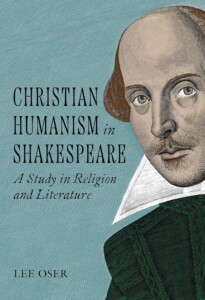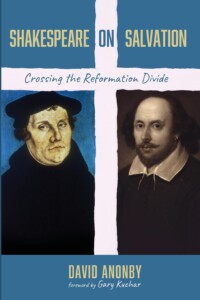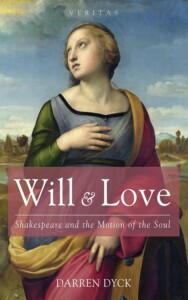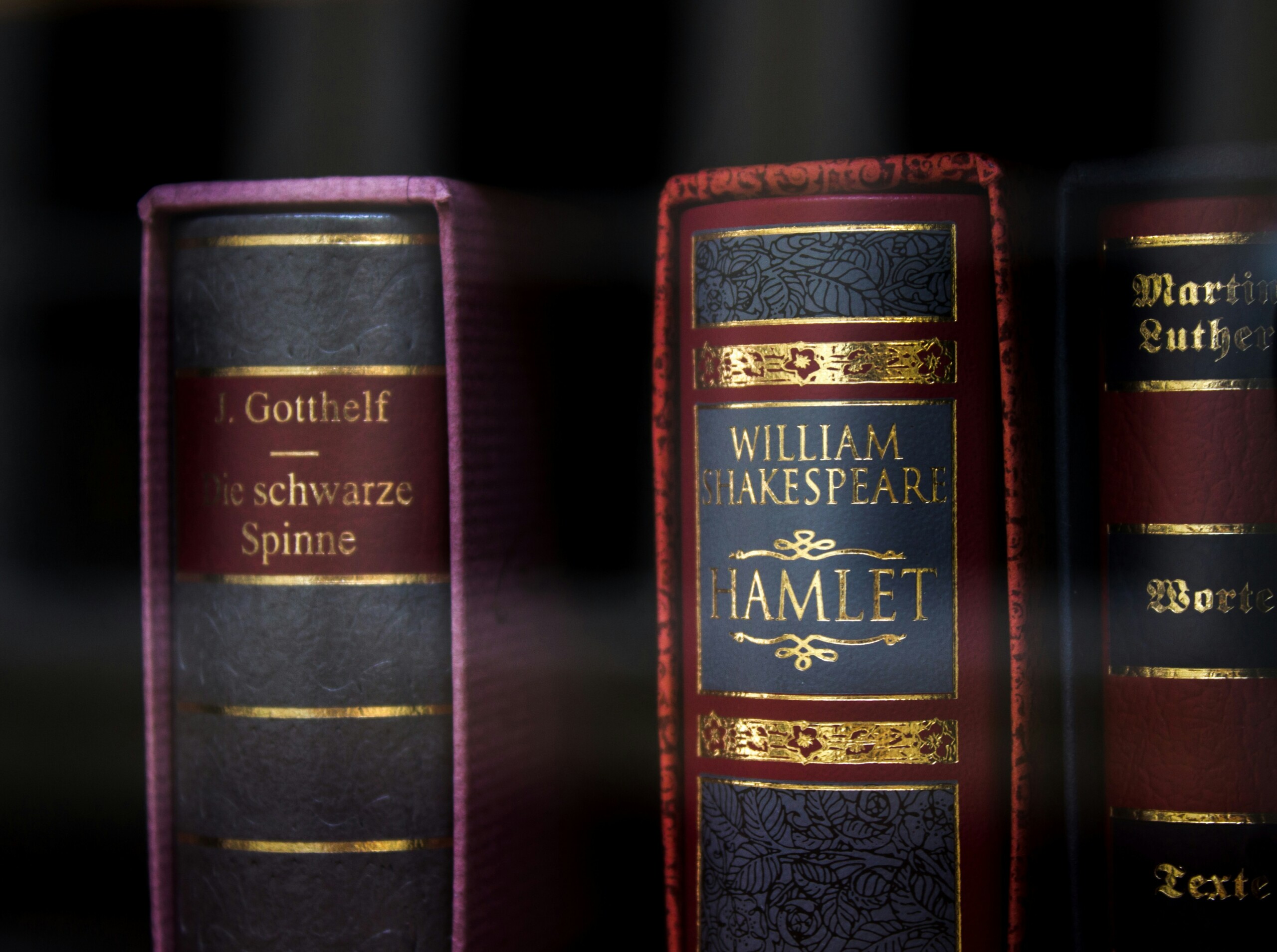
Christian Humanism in Shakespeare: A Study in Religion and Literature

Shakespeare on Salvation: Crossing the Reformation Divide

Will & Love: Shakespeare and the Motion of the Soul
Editor’s Note: Due to an earlier failure of the e-mail distribution of this three-part post, we are reposting it over the next three days.
It has been approximately twenty-five years since the “turn to religion” in Shakespeare studies. When I informally polled a few colleagues in history, psychology, and social work about a turn to religion in their fields of study, each identified a pivotal publication in the late 1990s or early 2000s in the scholarly literature. One is tempted to speculate on the coincidence of these “turns to religion” across academic disciplines. Was it the rise of sectarian fanaticism and religious extremism that prompted scholars to examine the role of religion in their areas of expertise? Was it the phenomenon of an intensifying culture war that put religion into focus as a legitimate causal variant? Was it the recognition of First Nations spirituality in indigenous studies? Was it the eschatological angst of Y2K? When Ken Jackson and Arthur F. Marotti reviewed the turn to religion in early modern studies, they concluded: “Clearly, the deconstructive response to Enlightenment rationality has opened up religious culture and religious study to new (but perhaps also old?) forms of apprehension and interpretation.”1 Ironically, then, the post-structuralist zeitgeist in the social sciences and humanities that relegated religion to a mere construct also is responsible for the readmission of religion in our disciplines.
This is not the time for triumphalism, however. Thanks to the influence of new historicism and cultural materialism in the 1980s and of critical theory in the 1990s, literary studies continue to approach religion in the Early Modern period as one expression of cultural discourse among many. Whereas the old historicism may have placed religion at the center of the cultural cosmos, religion after Foucault finds itself among a constellation of social institutions. The literary critical mood in the academy, as Rita Felski has described it in The Limits of Critique, remains suspicious of religion as an ideological state apparatus that underwrites oppressive practices regarding race, gender, and class.2 The “Shakespeare and Theory” series published by Bloomsbury under its influential The Arden Shakespeare imprint shows only a limited receptivity to religion in its promotion of contemporary critical theory and practice. Of the sixty-nine seminars and workshops at the 2025 gathering of The Shakespeare Association of America, only one session dealt directly with religion: “Shakespeare and Islam” explored representation, reception, and response in Muslim contexts. In post-graduate seminars, one is likely to encounter a Shakespeare who is in cahoots with the oppressive religious beliefs and practices of the period. At the same time, in high school English classes and undergraduate courses, Shakespeare is still read as embodying universal, humanist values but devoid of religious content, not unlike the secular humanist tenor of early twentieth-century criticism of Shakespeare. The fact that the three books being reviewed here are published by presses with religiously-inflected mandates and by authors affiliated with faith-based colleges suggests that the current (re)turn to religion in Shakespeare studies is not yet mainstream.
The past twenty-five years have seen various entry points into the territory of Shakespeare and religion. The long-standing contention about Shakespeare’s confessional allegiance has moved from focussing on biographical data to the texts themselves. Despite centuries of archival and archeological research into the life of William Shakespeare (1564–1616), the question of whether he was a recusant Roman Catholic or a practising Protestant cannot be definitively answered. Holy Trinity Church in Stratford-upon-Avon seems to have retained pre-Reformation vestiges of Catholicism after the accession of Elizabeth I in 1558, but how this fact relates to Shakespeare is unclear. Shakespeare’s daughter may have embraced the Old Faith as an adult, but this, at best, is circumstantial evidence of Shakespeare’s views. Even if the church records seem to indicate only a lukewarm affiliation with the Church of England, this material, too, is overly slender to bear the weight of a persuasive argument about Shakespeare’s faith. Thankfully, the three books reviewed here all eschew the biographical approach, focusing instead on what the plays reveal about the perduring vitality of Christian faith in these texts.
These books take religion to be the legitimate force in culture, rather than one cultural phenomenon among many. Whereas materialist criticism views religion as a construction on an economic base, or a symptom of the will to power, or a therapeutic practice, this re-turn to religion understands faith to be the oxygen that animates life itself, the grammar that gives meaning to reality, the architectonic that shapes the human world, the social imaginary that knits the body politic, the sine qua non of culture. Cultural artifacts from the Early Modern theater are saturated phenomena, to borrow Jean-Luc Marion’s phrase, whose religious content exceeds their form. As we will see later in this essay, religion is not reducible to matters of historical context, biographical data, Scriptural allusion, theological diction, biblical typology, and Christian allegory: religion is the generative DNA of the words on the page and the action on the stage. What makes Shakespeare particularly productive for exploring religion in the Early Modern period is his uneasy location in the ambivalent space between the enchanted medieval age and the disenchanted modern world, in terms of Charles Taylor’s framework in The Secular Age (2007).3 As such, the three books considered in this essay offer an opportunity to assess in more detail how religion works as a hermeneutic for reading Shakespeare’s plays. They complement each other well: Lee Oser demonstrates the extent to which the spirit of Erasmian humanism permeates Shakespeare’s Christian vision; David Anonby reads the role of soteriology in Shakespeare against theological positions of the period; and Darren Dyck traces Shakespeare’s conception of personhood back to its Augustinian roots. Each of these makes a significant contribution to the appreciation of the theological dynamics at work in Shakespeare, and each meaningfully advances the project of redressing the relative neglect of religion in Shakespeare studies.
Beginning with Christian Humanism in Shakespeare: A Study in Religion and Literature, Lee Oser situates his thesis for Shakespeare’s “immeasurable range, variety, and depth of Christian thought and feeling” (250) within “current understanding” (xiii) of religion and literature. In short, the current understanding is the tendency “to modernize, to secularize, to contain the religious and theological meanings of Shakespeare” (30). In his admittedly lengthy introduction, Oser responds to the suggestion that the plays do not reveal a “personal substratum” of faith (3) by engaging an impressive array of scholars, both those who read Shakespeare as primarily a secular author and those who read him as a Christian author. This extensive literature review is valuable for anyone wanting to become familiar with the question of religion and Shakespeare, and it is engaging as an example of civil disagreement in an academic context. For instance, while Oser dismisses the reductive nature of aggressive Christian allegorizing of Shakespeare, he notes that secular critics can be equally guilty of “writing teleological allegories” (8). Oser is certainly on point when he challenges the secularists for not dealing adequately with the nature of evil in the tragedies, and he illustrates the paucity of the secular approach in a nimble discussion of judgment in Romeo and Juliet: the passion and suffering that Shakespeare’s protagonists endure reflect Christian, rather than classical, mimesis, an observation that is further developed in the chapters on Hamlet and King Lear. Even as it makes the general case for religion in Early Modern literary studies, the introduction makes the specific case for reading the period as expressive of the Christian humanism of Erasmus.
The proof, of course, lies in the testing of the thesis against the evidence in the plays. Oser begins with what continues to be one of Shakespeare’s most popular comedies, A Midsummer Night’s Dream. Oser sets out to demonstrate how two themes in the play deploy the Christian humanist rhetorical strategy of paradox. First, Oser shows that Helena paradoxically achieves wisdom through folly in her journey of self-discovery through the forest near Athens. Oser here aligns Shakespeare’s insight with that of Erasmus in The Praise of Folly (1511, 1514) specifically and in Christian humanism generally: “fools and folly invite us to be skeptical about unexamined claims to knowledge and authority” (57). Limited skepticism is also the result of grappling with the second paradox in the play, between free will and predestination. Oser will return to the Reformation-era debate about the bondage or freedom of the will in his chapter on Hamlet, but Shakespeare already in A Midsummer Night’s Dream allows the audience to see the apparent contradiction of freedom and determination to find resolution in Helena’s choices and in Oberon’s foreknowledge. Both paradoxes can be summed up in Oser’s view that the comedy performs “Shakespeare’s idea of human freedom within religious bounds, . . . a playful expression of the poet’s urbane Christian skepticism” (80).
Christian skepticism is the crucial piece in Oser’s argument regarding Shakespeare’s humanism. In chapter 2, Oser argues that the morally ambiguous effect of The Merchant of Venice on the audience is produced by means of rhetorical figures deeply indebted to Renaissance humanism. Oser contends that the Christian character of Renaissance humanism radically challenges the epistemological assurance of classical philosophy: “Shakespearean rhetoric in its moral design is less a means of persuasion than a Christian game of moral interrogation” (85). The moral figures that Shakespeare deploys in A Merchant of Venice include inter se pugnantia (theory versus practice), secundum quid (false assumption), and, most materially, contrarium and contradictio (conflicting interpretation). All of these, Oser demonstrates, amount to a conviction of the via diversa of truth, arriving by indirect means at the realization that moral absolutes are elusive. “Because Shakespeare’s skepticism is not anti-foundational, The Merchant of Venice is not a debunking of Christian moral truth, per se, but an insistence upon its humbling complexity” (88). Shakespeare occupies the radical middle between the confident doctrines of Catholic and Reformed theology on the one hand and morally bankrupt protagonists in Christopher Marlowe on the other.
Oser then turns to the four English history plays that Shakespeare wrote between 1595–1599, known as the Henriad. In the writing of history, one may be tempted to assert eternal providence and justify the ways of God to the Englishman. As he works his way carefully through the four plays that comprise the Henriad, Oser consistently demonstrates that Shakespeare resists this temptation by revealing the limits of human knowledge in serious, Christian terms. The history plays achieve this by maintaining “a skeptical distance from major inferences of cause and effect” (127). In The Tragedy of Richard the Second, Shakespeare erodes the audience’s trust in the historical record and sows doubts about the vows and oath-keeping through irony. Thanks to the prophetic role of John of Gaunt, this play does appeal to “Christian ulteriority” (134, 169), by which British history is mapped onto the broad contours of biblical history. In both parts of Henry the Fourth, Oser unpacks what he calls Shakespeare’s “Christian mimesis” (148): the theater is the location where Shakespeare points his religious sensibility critically toward political instrumentalism, Puritan zealotry, and Tudor myth-making by suggestion, allusion, and jesting. At the same time, the conversion of Prince Hal into King Henry the Fifth, Oser suggests, is not a cynical Machiavellian move but is a redemptive chapter in the arc of England’s history. The Henriad ends with “oaths well kept and prosperous” (Henry V, 5.2.373) by which the sanctity of vows, which was seriously compromised in The Tragedy of Richard the Second, is restored.
The final two chapters (“Free Will in Hamlet?” and “On Not Understanding King Lear’s Hidden God”) are more focused than the previous chapters in advancing the same argument about Shakespeare’s Christian humanism. Hamlet is conflicted, not for psychological or philosophical reasons, but because he embodies the Reformation controversy of the will between Luther and Erasmus. In the final act of the play, Hamlet both expresses trust in providence (à la Luther) and accepts his freedom of choice (à la Erasmus). Between alternative accounts of agency and non-agency, Shakespeare remains ambiguous. The audience is left in uncertainty, made aware again of the limits of their knowing and the absence of moral absolutism. Such indeterminacy is a function, not of radical skepticism, but of Christian humanism. With King Lear, Oser avoids simplistic interpretation of the play’s ending (and the question of redemption) by maintaining that Shakespeare emphasizes the play’s process, namely, the necessity of tragic suffering. One of the challenges of a Christian reading of King Lear is the fact that the action is set in pre-Christian, pagan Britain. Therefore, when France invokes Christian concepts, Shakespeare is setting up a test for his audience regarding two moral frameworks, pagan and Christian. The metaphorical function of blindness in the play is an allusion to Sophocles and the blind seer, Teiresias, as well as the nature of suffering experienced by Gloucester and Lear. For Oser, the religious sensibility of The Tragedy of King Lear is unlocked not by an allegorical key but by its recognition of suffering as a means of grace, something that Melanchthon and Erasmus would have appreciated (248). Aristotelian mimesis is modified by Christian mimesis.
























One Comment